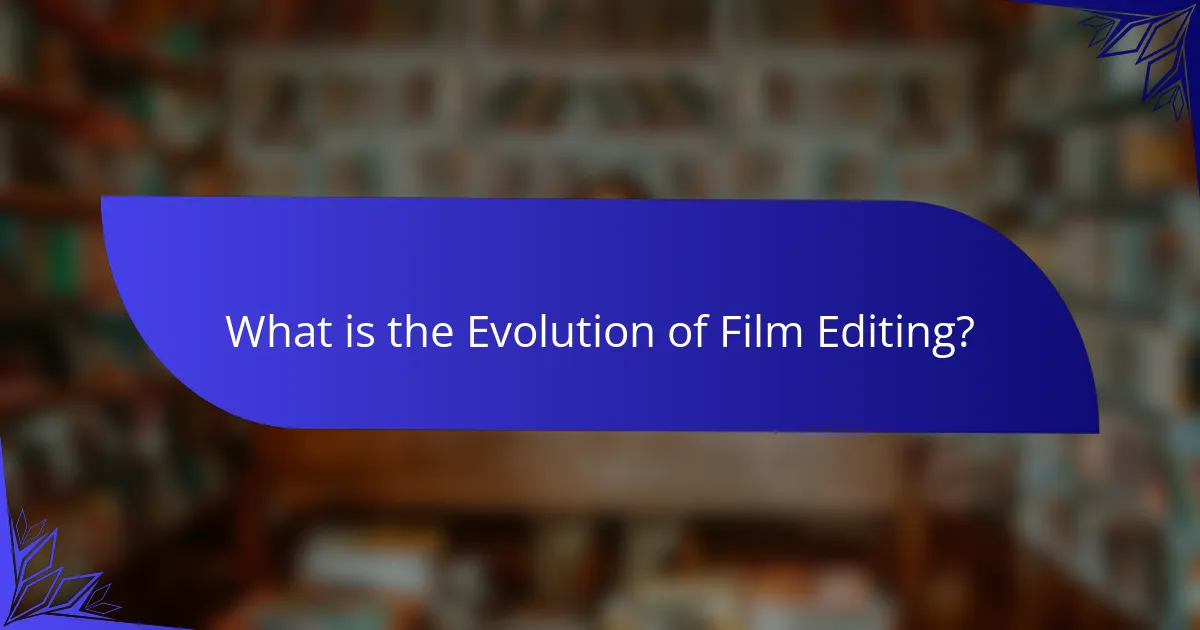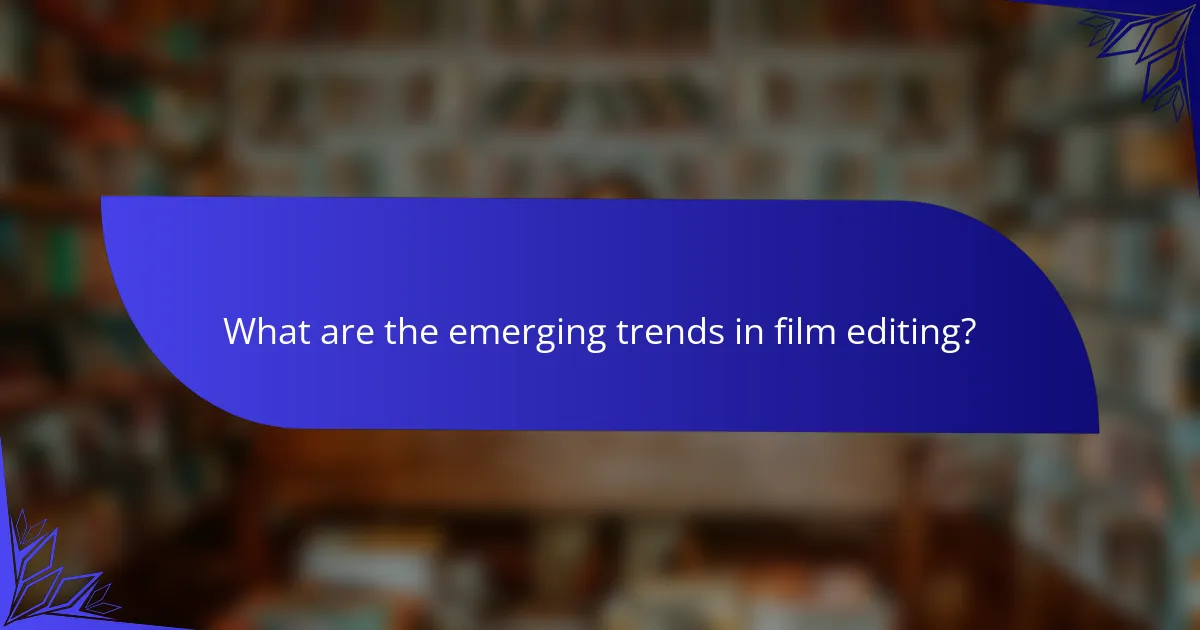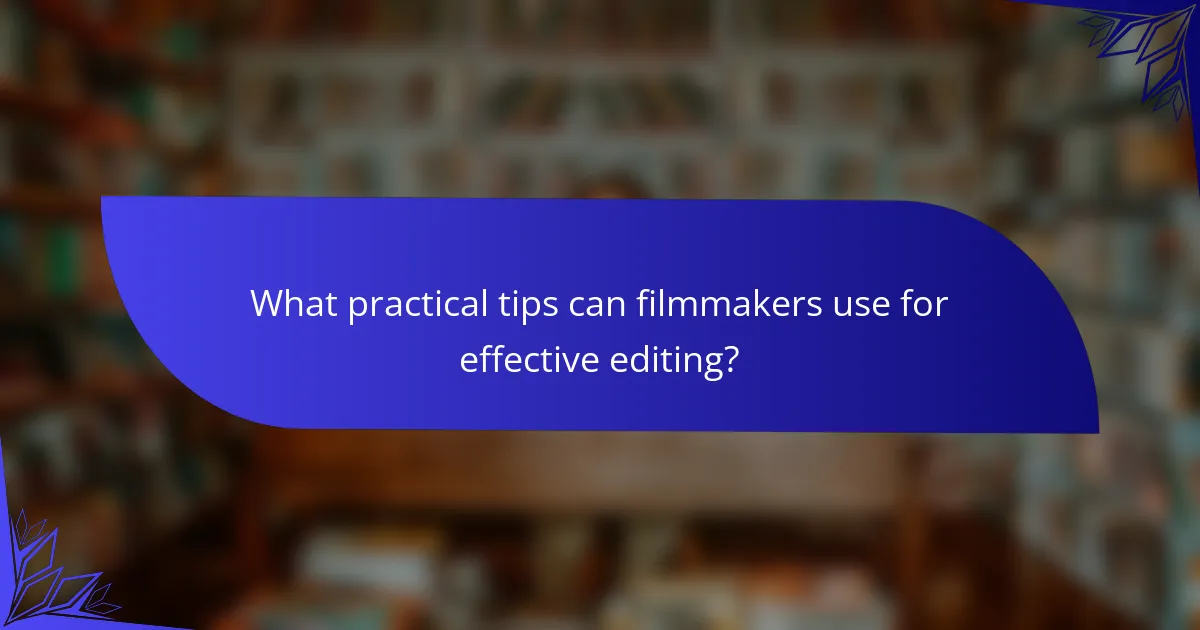The article examines the evolution of film editing, detailing the historical progression of techniques used to assemble film footage. It highlights key milestones, including early editing methods, the introduction of narrative editing by pioneers like Edwin S. Porter, and the impact of sound on editing rhythms. The discussion progresses through significant technological advancements, such as the transition to digital editing in the 1990s and the rise of non-linear editing systems. Emerging trends in film editing, including the use of artificial intelligence, cloud-based platforms, and adaptations for virtual and augmented reality, are also explored. Additionally, practical tips for effective editing are provided, emphasizing the importance of a clear narrative vision, efficient software use, and collaboration with sound designers and colorists.

What is the Evolution of Film Editing?
The evolution of film editing refers to the progression and transformation of techniques used to assemble film footage. Early editing in the late 19th century involved simple cuts between scenes. Pioneers like Edwin S. Porter introduced narrative editing with films like “The Great Train Robbery” in 1903. The introduction of the editing table in the 1920s allowed for more complex arrangements. The advent of sound in the late 1920s changed editing rhythms to match audio cues. The 1960s saw the rise of montage editing, emphasizing emotional impact. Digital editing emerged in the 1990s, revolutionizing the process with software like Avid Media Composer. Today, editing is characterized by non-linear editing systems, allowing for greater flexibility and creativity. The evolution reflects technological advancements and changing storytelling techniques in cinema.
How has film editing changed over the decades?
Film editing has evolved significantly over the decades. In the early 1900s, editing was rudimentary and primarily involved cutting physical film strips. The introduction of synchronized sound in the late 1920s changed editing techniques, as filmmakers had to consider audio alongside visuals. The 1960s and 1970s saw the rise of more complex editing styles, influenced by the French New Wave and the use of jump cuts.
The advent of digital technology in the 1990s revolutionized film editing. Non-linear editing systems, like Avid Media Composer, allowed editors to manipulate footage more freely. This shift enabled faster editing processes and greater creative possibilities. Today, film editing incorporates advanced software that supports visual effects and real-time collaboration.
As a result, contemporary editing techniques are more dynamic and integrated with other production elements. The transition from analog to digital has also democratized film editing, making it accessible to independent filmmakers. Overall, film editing has transformed from basic cuts to sophisticated, technology-driven processes.
What were the early techniques used in film editing?
Early techniques used in film editing included cutting, splicing, and the use of intertitles. Cutting involved physically removing sections of film to create a desired sequence. Splicing was the process of joining two pieces of film together, often using tape. Intertitles were inserted text cards that provided dialogue or context between scenes. These methods were fundamental in shaping narrative flow. They allowed filmmakers to control pacing and storytelling. Techniques evolved as technology advanced, leading to more sophisticated editing tools. Early editors laid the groundwork for modern editing practices.
How did technological advancements influence editing styles?
Technological advancements significantly influenced editing styles by introducing new tools and techniques. The transition from film to digital editing allowed for greater flexibility and efficiency. Non-linear editing systems (NLE) emerged, enabling editors to access any part of the footage instantly. This shift facilitated more creative storytelling and complex visual effects. Additionally, advancements in software provided features like color grading and sound design integration. These tools enhanced the overall quality and aesthetic of films. The rise of high-definition and 4K technology further pushed the boundaries of visual storytelling. Each of these advancements reshaped the way editors approach their craft.
Why is film editing considered an art form?
Film editing is considered an art form because it shapes the narrative and emotional impact of a film. Editors select and arrange footage to create a coherent story. This process requires creativity and technical skill. The pacing and rhythm established by editing can influence audience engagement. Techniques such as cuts, transitions, and montages contribute to storytelling. Historical examples, like those used by directors such as Alfred Hitchcock, showcase the power of editing. Editing can evoke specific emotions and highlight thematic elements. The artistry in film editing is evident in award-winning films recognized for their editing excellence.
What creative techniques do editors use to enhance storytelling?
Editors use various creative techniques to enhance storytelling in film. These techniques include pacing, transitions, and the use of sound. Pacing controls the rhythm of a scene, affecting audience engagement. Editors often manipulate the tempo to build tension or provide relief. Transitions, such as cuts and fades, help to guide the viewer through the narrative. Smooth transitions can maintain continuity and enhance emotional impact. Sound design, including sound effects and music, complements visuals and reinforces themes. For example, a suspenseful score can heighten tension during critical moments. These techniques have been pivotal in shaping cinematic storytelling, as evidenced by films that rely heavily on editing to convey complex narratives.
How do editing choices impact the audience’s emotional response?
Editing choices significantly shape the audience’s emotional response. The pacing of edits can create tension or relief. Quick cuts may heighten anxiety, while slow transitions can evoke calmness. The selection of shots influences the viewer’s connection to characters. Emotional music paired with specific scenes amplifies feelings. For instance, a study by K. A. Hu and R. A. McCauley found that editing styles directly affect emotional engagement. This research indicates that audiences respond differently to various editing techniques. Thus, editing serves as a powerful tool in eliciting specific emotional reactions.
What are the key milestones in the history of film editing?
The key milestones in the history of film editing include the introduction of the cut by Edwin S. Porter in 1903. This technique allowed filmmakers to create narratives by juxtaposing different scenes. In 1927, the advent of sound films required new editing techniques to synchronize audio and visuals. The 1930s saw the development of continuity editing, which aimed for a seamless narrative flow. The 1960s introduced more experimental editing styles, influenced by filmmakers like Jean-Luc Godard. Digital editing emerged in the 1990s, revolutionizing the editing process with non-linear editing systems. The 21st century brought advancements in software, enabling greater creative possibilities in film editing. Each milestone reflects the evolving nature of storytelling in cinema.
Which films marked significant shifts in editing techniques?
“Birth of a Nation” (1915) marked a significant shift in editing techniques. It introduced the use of cross-cutting to build tension and narrative complexity. “The Battleship Potemkin” (1925) further innovated with montage editing to evoke emotional responses. “Psycho” (1960) revolutionized editing in horror with rapid cuts during the shower scene, influencing suspense techniques. “Star Wars” (1977) employed digital editing techniques that changed the visual storytelling landscape. Each of these films demonstrated new approaches that reshaped the art of editing in cinema.
How did the introduction of digital editing transform the industry?
The introduction of digital editing transformed the film industry by significantly enhancing efficiency and accessibility. Digital editing allows for non-linear editing, enabling editors to access any part of the footage instantly. This contrasts with traditional linear editing, which required sequential tape-based processes. The shift to digital also reduced costs associated with film stock and physical editing equipment. Editing software, such as Adobe Premiere Pro and Final Cut Pro, democratized the editing process. More filmmakers can now produce high-quality content without substantial financial investment. According to a report by the International Film Industry Association, digital editing has increased production speed by up to 50%. This transformation has led to a surge in independent filmmaking and diverse storytelling.
How do current innovations shape film editing practices?
Current innovations significantly shape film editing practices by introducing advanced technology and software. These innovations enhance efficiency and creativity in the editing process. For instance, artificial intelligence tools can automate repetitive tasks, allowing editors to focus on storytelling. Cloud-based editing platforms enable real-time collaboration among teams regardless of location. Additionally, high-resolution formats and virtual reality editing tools provide new creative possibilities. The integration of machine learning algorithms helps in organizing and tagging footage, making it easier to locate specific scenes. Innovations in hardware, such as faster computers and specialized editing consoles, streamline workflows. These advancements collectively transform traditional editing methods into more dynamic and flexible practices.
What role does software play in modern film editing?
Software plays a crucial role in modern film editing by providing tools for digital manipulation of footage. It enables editors to cut, rearrange, and enhance video clips efficiently. Advanced software allows for seamless integration of audio and visual elements. Programs like Adobe Premiere Pro and Final Cut Pro offer features such as color correction and special effects. These tools streamline the editing process, reducing time and effort. Software also supports collaboration among multiple editors and teams. Cloud-based platforms facilitate real-time sharing and feedback. Overall, software has transformed film editing into a more accessible and creative process.
How are new technologies like AI influencing editing processes?
New technologies like AI are significantly influencing editing processes by automating tasks and enhancing precision. AI algorithms can analyze footage quickly, identifying key scenes and suggesting edits. This reduces the time editors spend on repetitive tasks. For example, AI tools can automatically color grade footage based on learned preferences. They can also assist in sound editing by recognizing audio patterns and suggesting improvements. Additionally, AI can provide real-time feedback during the editing process, allowing for faster adjustments. Research shows that AI-driven editing software can improve productivity by up to 30%. This integration of AI is reshaping the editing landscape, making it more efficient and innovative.

What are the emerging trends in film editing?
Emerging trends in film editing include the use of artificial intelligence and machine learning. These technologies streamline the editing process by automating tasks like scene detection and color correction. Cloud-based editing platforms are also gaining popularity. They allow for real-time collaboration among editors and filmmakers, regardless of location. Additionally, the rise of virtual reality and augmented reality is influencing editing styles. Editors are adapting techniques to create immersive experiences for viewers. Another trend is the integration of social media formats into traditional editing. This caters to shorter attention spans and the demand for quick content. Finally, editors are increasingly focusing on storytelling through non-linear narratives. This approach enhances viewer engagement and adds complexity to films.
What techniques are gaining popularity among contemporary editors?
Techniques gaining popularity among contemporary editors include the use of digital editing software, non-linear editing systems, and collaborative editing platforms. Digital editing software like Adobe Premiere Pro and Final Cut Pro allows for greater flexibility and efficiency. Non-linear editing systems enable editors to access any part of the footage without following a linear sequence. Collaborative editing platforms, such as Frame.io, facilitate real-time feedback among teams. These techniques enhance productivity and creativity in the editing process. The rise of streaming services has also influenced editors to adopt faster workflows. Overall, these trends reflect the industry’s shift towards more technology-driven and collaborative practices.
How is the rise of streaming platforms affecting editing styles?
The rise of streaming platforms is significantly changing editing styles. Editors are adapting to shorter attention spans of audiences. This results in faster cuts and more dynamic pacing. Additionally, streaming content often requires a variety of formats. Editors must create versions suitable for mobile, TV, and cinema. This versatility influences how scenes are structured and transitions are handled. Moreover, binge-watching trends encourage cliffhangers and suspenseful edits. These changes reflect the need to engage viewers continuously. Overall, streaming platforms are shaping a more rapid and varied editing landscape.
What trends are shaping the future of narrative editing?
Trends shaping the future of narrative editing include increased use of artificial intelligence, real-time collaboration tools, and immersive storytelling techniques. Artificial intelligence is being integrated to enhance editing efficiency and automate repetitive tasks. Real-time collaboration tools allow multiple editors to work simultaneously on projects, improving workflow. Immersive storytelling techniques, such as virtual reality and augmented reality, are creating new narrative possibilities. These trends are supported by advancements in technology and growing demands for innovative content. The film industry is adapting to these changes to engage audiences more effectively.
How is film editing evolving in response to audience preferences?
Film editing is evolving to align more closely with audience preferences for pacing and engagement. Modern audiences prefer faster cuts and dynamic editing styles. This shift is evident in the popularity of action and thriller genres, which utilize rapid transitions. Research indicates that films with quicker edits often perform better at the box office. For instance, studies show that films with an average of 6-10 seconds per shot attract more viewers. Additionally, streaming platforms are influencing editing trends. They often favor shorter episodes and engaging content to retain viewer attention. Consequently, editors are adapting by incorporating techniques that enhance viewer retention and emotional impact.
What impact does viewer engagement have on editing decisions?
Viewer engagement significantly influences editing decisions in film and video production. High viewer engagement often leads to tighter pacing and more dynamic cuts. Editors analyze viewer feedback to determine which scenes resonate most effectively. This data-driven approach allows for adjustments that enhance emotional impact. For instance, scenes that maintain viewer attention are prioritized in the final cut. Conversely, segments that fail to engage may be shortened or removed entirely. The rise of analytics tools has made it easier to gauge audience reactions in real-time. This trend reflects a shift towards audience-centric editing practices in the industry.
How are editors adapting to shorter attention spans?
Editors are adapting to shorter attention spans by creating concise, engaging content. They focus on shorter scenes and quicker cuts to maintain viewer interest. Techniques like jump cuts and fast-paced montages are increasingly used. Editors also prioritize impactful visuals and sound design to capture attention quickly. Additionally, they utilize data analytics to understand audience preferences. This data helps inform editing choices that resonate with viewers. The shift towards mobile viewing has also influenced editing styles. Editors are now crafting content that is optimized for social media platforms. This adaptation reflects a broader trend in media consumption habits.

What practical tips can filmmakers use for effective editing?
Filmmakers can use several practical tips for effective editing. First, they should develop a clear vision of the story. This clarity helps in making cohesive cuts that enhance the narrative. Second, utilizing editing software efficiently can streamline the process. Tools like Adobe Premiere Pro and Final Cut Pro offer features that improve workflow. Third, maintaining a consistent pace throughout the film is crucial. This ensures that the audience remains engaged. Fourth, filmmakers should consider the rhythm of dialogue and sound. Proper timing can elevate emotional impact. Fifth, reviewing footage multiple times aids in identifying the best takes. This practice can lead to more polished final cuts. Lastly, collaborating with sound designers and colorists can enhance the overall quality. Research indicates that effective collaboration can significantly improve the final product.
What best practices should editors follow to enhance their work?
Editors should follow best practices such as maintaining a clear workflow and ensuring effective communication. A clear workflow helps streamline the editing process. It allows editors to track progress and manage time efficiently. Effective communication fosters collaboration with directors and other team members. Regular feedback sessions can enhance the quality of the final product. Additionally, staying updated with industry trends and technology is crucial. This knowledge enables editors to utilize new tools and techniques effectively. Research shows that editors who adopt these practices produce higher quality work and meet deadlines more consistently.
How can editors maintain a cohesive narrative throughout a film?
Editors maintain a cohesive narrative throughout a film by ensuring continuity in storytelling and visual elements. They achieve this by carefully selecting and arranging shots to create a logical flow. Editors use techniques such as match cuts and transitions to link scenes seamlessly. They also pay attention to pacing, which affects how the story unfolds over time. Consistent character development is crucial for maintaining audience engagement. Editors often refer to a script or storyboard for guidance on narrative structure. They collaborate closely with directors to align the vision and tone of the film. Utilizing feedback from test screenings helps editors refine the narrative further. Overall, these practices contribute to a unified and engaging cinematic experience.
What common mistakes should be avoided during the editing process?
Common mistakes to avoid during the editing process include neglecting to review the footage thoroughly. Failing to check for continuity errors can disrupt the flow of the film. Overlooking sound quality is another critical mistake. Poor audio can detract from the viewer’s experience. Additionally, excessive cuts can lead to a disjointed narrative. Maintaining a coherent story arc is essential for audience engagement. Ignoring feedback from peers or test audiences can also hinder the editing process. Constructive criticism often leads to improvements. Lastly, not saving multiple versions of the project can result in loss of work. Regular backups are crucial for safeguarding edits.
The main entity of the article is film editing, which encompasses the historical techniques, innovations, and future trends in the field. The article outlines the evolution of film editing from its early rudimentary methods to the sophisticated digital techniques used today, highlighting key milestones and influential films. It discusses the impact of technological advancements, such as the transition from analog to digital editing and the integration of AI, on editing styles and practices. Additionally, the article explores emerging trends, best practices for filmmakers, and common mistakes to avoid in the editing process, providing a comprehensive overview of the dynamic landscape of film editing.